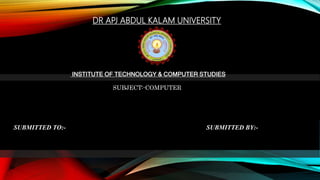
DR APJ ABDUL KALAM UNIVERSITY COMPUTER STUDIES
- 1. DR APJ ABDUL KALAM UNIVERSITY INSTITUTE OF TECHNOLOGY & COMPUTER STUDIES SUBMITTED BY:-SUBMITTED TO:- SUBJECT:-COMPUTER
- 2. THE COMPUTER Computer Genesis, component‘s, Hardware & Software Slide By Pradeep
- 3. GENERATION OF COMPUTERS Based on the characteristics of various computers developed from time to time, they are categorized as generation of computers. Generation of Computers First Generation Second Generation Third Generation Fourth Generation Fifth Generation
- 4. FIRST GENERATION COMPUTERS Time Period : 1951 to 1959 Technology : Vacuum Tubes Size : Very Large System Processing : Very Slow Characterized By:- Magnetic Drums • Magnetic Tapes • Difficult to program • Used machine language & assembly language
- 5. SECOND GENERATION COMPUTERS Time Period : 1959 to 1963 Technology : Transistors Size : Smaller Processing : Faster Characterized By:- • Magnetic Cores • Magnetic Disk • Used high level language • Easier to program
- 6. THIRD GENERATION COMPUTERS Time Period : 1963 to 1975 Technology : ICs (Integrated Circuits) Incorporated many transistors & electronic circuits on a single chip Size : Small as compared to 2nd generation computers Processing : Faster then 2nd generation computers Characterized by:- • Minicomputers accessible by multiple users from remote terminals.
- 7. FOURTH GENERATION COMPUTERS Characterized by: The personal computer and user friendly micro-programs, very fast processor chip high level language, OOP (Object Oriented Programming) Time Period : 1975 to Today Technology : VLSI (Very Large Scale Integration) Incorporated many millions of transistors & electronic circuits on a single chip Size : Small as compared to first generation computer Processing : Faster then first generation computer
- 8. FIFTH GENERATION COMPUTERS Time Period : Future Technology Technology : AI (Artificial Intelligence)
- 9. COMPUTER - COMPONENTS All types of computers follow the same basic logical structure and perform the following five basic operations for converting raw input data into information useful to their users.
- 10. (CONTINUED…) SL. NO. OPERATION DESCRIPTION 1 Take Input The process of entering data and instructions into the computer system. 2 Store Data Saving data and instructions so that they are available for processing as and when required. 3 Processing Data Performing arithmetic, and logical operations on data in order to convert them into useful information. 4 Output Information The process of producing useful information or results for the user, such as a printed report or visual display. 5 Control the workflow Directs the manner and sequence in which all of the above operations are performed.
- 11. INPUT UNIT This unit contains devices with the help of which we enter data into the computer. This unit creates a link between the user and the computer. The input devices translate the information into a form understandable by the computer.
- 12. CPU (CENTRAL PROCESSING UNIT) CPU is considered as the brain of the computer. CPU performs all types of data processing operations. It stores data, intermediate results, and instructions (program). It controls the operation of all parts of the computer. • CPU itself has the following three components − • ALU (Arithmetic Logic Unit) • Memory Unit • Control Unit
- 13. OUTPUT UNIT The output unit consists of devices with the help of which we get the information from the computer. This unit is a link between the computer and the users. Output devices translate the computer's output into a form understandable by the users.
- 14. COMPUTER - HARDWARE Hardware represents the physical and tangible components of a computer, i.e. the components that can be seen and touched. Examples of Hardware are the following − Input devices − keyboard, mouse, etc. Output devices − printer, monitor, etc. Secondary storage devices − Hard disk, CD, DVD, etc. Internal components − CPU, motherboard, RAM, etc.
- 15. RELATIONSHIP BETWEEN HARDWARE AND SOFTWARE • Hardware and software are mutually dependent on each other. Both of them must work together to make a computer produce a useful output. • Software cannot be utilized without supporting hardware. • Hardware without a set of programs to operate upon cannot be utilized and is useless. • To get a particular job done on the computer, relevant software should be loaded into the hardware. • Hardware is a one-time expense. • Software development is very expensive and is a continuing expense. • Different software applications can be loaded on a hardware to run different jobs. • A software acts as an interface between the user and the hardware. • If the hardware is the 'heart' of a computer system, then the software is its 'soul'. Both are complementary to each other
- 16. COMPUTER - SOFTWARE Software is a set of programs, which is designed to perform a well-defined function. A program is a sequence of instructions written to solve a particular problem. There are two types of software − • System Software • Application Software
- 17. BUSINESS SOFTWARE (OR A BUSINESS APPLICATION) Business software (or a business application) is any software or set of computer programs used by business users to perform various business functions. These business applications are used to increase productivity, to measure productivity and to perform other business functions accurately. By and large, business software is likely to be developed to meet the needs of a specific business, and therefore is not easily transferable to a different business environment, unless its nature and operation is identical. Due to the unique requirements of each business, off-the-shelf software is unlikely to completely address a company's needs. However, where an on-the-shelf solution is necessary, due to time or monetary considerations, some level of customization is likely to be required. Exceptions do exist, depending on the business in question, and thorough research is always required before committing to bespoke or off-the-shelf solutions.
- 18. VARIOUS BUSINESS SOFTWARE DEVELOPERS
- 19. Slide By Pradeep